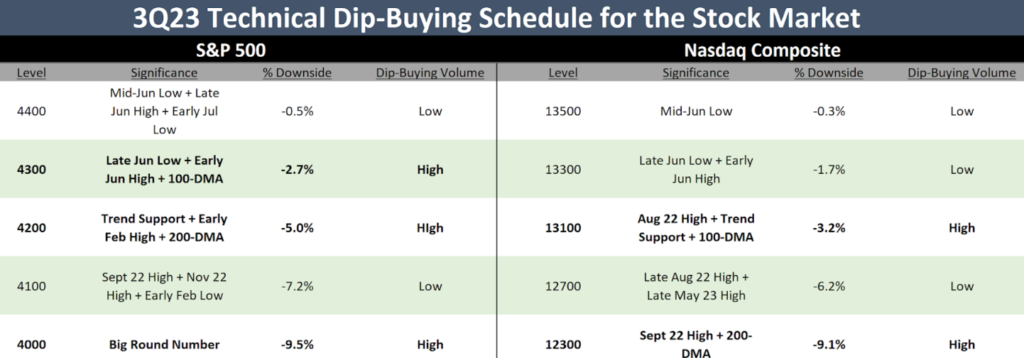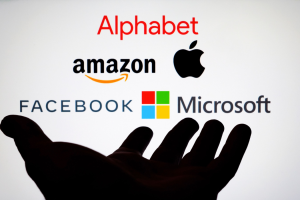
Powell disappoints … bullish short-term technical indicators … the Coppock Curve is flashing “bull” … a buy-schedule if weakness intensifies … a “reincarnation” of the ‘90s?
Federal Reserve Chairman Jerome Powell isn’t helping…
Speaking at the Fed’s annual retreat in Jackson Hole, this morning, Powell largely echoed familiar talking points: despite progress, inflation remains too high… the Fed wants to bring inflation down without damaging the economy more than necessary… the Fed will be data dependent… yada yada yada…
Here’s an excerpt from Powell’s comments that provides a good sum-up:
Doing too little could allow above-target inflation to become entrenched and ultimately require monetary policy to wring more persistent inflation from the economy at a high cost to employment.
Doing too much could also do unnecessary harm to the economy…
As is often the case, we are navigating by the stars under cloudy skies.
As I write early-afternoon, the three major indexes are up slightly after being down earlier in the day. It appears Wall Street is trying to shake off its disappointment that Powell’s tone wasn’t more dovish.
Here’s CNBC with why Wall Street is sulking:
[Powell] gave no sign that he’s even considering a rate cut.
“At upcoming meetings, we will assess our progress based on the totality of the data and the evolving outlook and risks,” Powell said.
“Based on this assessment, we will proceed carefully as we decide whether to tighten further or, instead, to hold the policy rate constant and await further data.”
Adding insult to injury, Powell wasn’t shy about the possibility of enacting even more rate hikes, making the point again:
We are prepared to raise rates further if appropriate, and intend to hold policy at a restrictive level until we are confident that inflation is moving sustainably down toward our objective.
Despite Wall Street’s subdued reaction as I write, a study of market history shows that stocks demonstrate an upward bias in the wake of these Jackson Hole symposiums after more time has passed.
Barron’s reports that since 1978, in the month following this Fed symposium, the Dow, S&P 500, and Nasdaq have averaged gains of 0.1%, 0.3%, and Nasdaq 0.6% respectively.
So, if Powell’s comments this morning are mostly a non-event, when will the market return to bullishness?
According to our hypergrowth expert Luke Lango, any moment now – and he has loads of data supporting this forecast.
Better still, on the other side of this recent market softness, Luke sees a healthy, multi-year bull market. That’s why he’s urging his subscribers to remember the bigger picture:
Stay patient. The market will snap back into rally mode. When it does, your patience will turn into profits.
Let’s dive into the numbers behind Luke’s analysis.
The data suggesting this market selloff is nearly over
From Luke’s Daily Notes in Innovation Investor:
…All of our long-term trend indicators suggest this is just a garden-variety sell-off, while all of our short-term trend indicators suggest that – if this is indeed just a garden-variety sell-off – the market has hit or is very close to hitting a bottom.
Simply consider for the S&P 500:
– The Relative Strength Index has crashed to below 35, where it bottomed in the March and December sell-offs.
– The McClellan Oscillator has dropped to -55, where it bottomed in the March and December sell-offs.
– The Stochastic Oscillator has dropped below 5, where it bottomed during the March and December sell-offs.
– The market has broken below its lower Bollinger Band, something it also did near the bottoms of the March and December sell-offs.
In other words, all technical signals suggest that if this is indeed just a garden-variety sell-off like we saw in December 2022 and March 2023, then we are either at or very close to a bottom.
On the long-term trend front, Luke notes the S&P remains above its 100-day and 200-day moving averages… the 50-, 100-, and 200-day moving averages are all still sloping upward… and the monthly Coppock Curve on the S&P 500 is positive and moving higher.
Let’s look in greater detail at this Coppock Curve since it’s Luke’s favorite long-term technical indicator for the stock market. As you’re about to see, it just fired off a very bullish signal.
A “100% track record of coinciding with big, new bull markets”
The Coppock Curve is a technical analysis tool used by traders and analysts to identify long-term buying opportunities in the market by pinpointing major market bottoms or turning points after significant declines.
It does this by flagging shifting momentum that suggests the early stages of a new bullish trend. Technical analysts consider crossovers from negative to positive reading as transitions from bear to bull markets.
With that context, here’s Luke:
We just completed a bullish Coppock Curve crossover for the first time in this cycle.
Here in August, the Coppock Curve jumped into positive territory for the first time since 2022. It marks the first bullish Coppock Curve crossover since early 2010 (when stocks were rebounding from 2008 financial crisis and Wall Street was entering a new bull market that lasted for a decade.
That itself was the first bullish crossover since late 2003 (when stocks were rebounding from the dot-com crash and entering a new bull market that lasted for five years).
This Coppock crossover is bullish enough by itself, but there’s another detail in the data amplifying the potential bullishness
Luke points out that earlier this year, the Coppock Curve on the S&P 500 sat in deeply negative territory, at roughly -25. Today, the curve is in positive territory.
Here’s Luke for the significance of this massive move:
This upward thrust from deeply negative to positive readings has a 100% track record of coinciding with big, new bull markets.
This happened in early 2010 and late 2003, after the 2008 financial crisis and dot-com crash officially ended, respectively – and before stocks went on a multi-year tear higher.
To be clear, Luke isn’t cherry-picking data from just the last couple decades. He points out that this same transition from a deeply negative Coppock reading to a positive one also happened in the early innings of multi-year bull markets in the early 1980s, mid-1970s, early 1970s, and early 1960s.
Whether you’re a bull or bear, it’s hard to argue with historical data.
Here’s Luke’s bottom line on the Coppock Curve:
Over the past 70 years, whenever this same bullish signal flashed, stocks were in the early innings of a massive, multi-year surge higher.
And that’s why we’re confident this time won’t be different.
We believe this pullback is offering a golden buying opportunity before stocks resume their unstoppable 2023 rally. Which is why you need to be buying this temporary August dip.
If you missed it, on Monday, Luke provided a detailed roadmap for how to take advantage of this August dip
He gave his subscribers a “technical dip-buying schedule” that identifies the levels that could serve as local bottoms (which means good buying opportunities) for the S&P 500 and Nasdaq.
Here it is again if you didn’t catch that Digest.
If you’re having trouble reading it, the high-conviction buy levels for the S&P are 4,300, 4,200, and 4,000.
For the Nasdaq, they’re 13,100 and 12,300.
Here’s Luke with more:
This schedule is not a hard rule. Rather, it is a guideline for us as we navigate current market volatility and look for buying opportunities…
…Some of these levels are weaker than others, and therefore, our dip-buying efforts will likely have different magnitudes at different times.
At some levels, we will nibble. At others, we will gobble. And we will continue to focus on buying laggards, short-squeeze contenders, and reasonably valued AI stocks…
But by employing this dip-buying schedule and rolling into this selloff, we believe we are putting ourselves in the best position possible to turn today’s weakness into significant profit by the end of the year.
Is history going to repeat itself?
Before we sign off, one quick historical parallel that supports a bullish view of today’s market…
All year, Luke has been making comparisons between AI’s impact on today’s stock market and the internet’s impact on the market back in the 1990s.
Yesterday, in the wake of the blowout earnings report from AI leader Nvidia, Wedbush Securities analyst Dan Ives joined Luke in this comparison:
“…Investors now recognize crystal clear [that] this AI demand story is as REAL as any tech trend we have seen in the last 30 years, only comparable to the internet in 1995 and Apple’s iPhone launch in 2007.”
Here’s Luke’s response:
Indeed, we also think that’s really the best way to look at this AI Boom. It is the reincarnation of the dot-com boom.
Just look at how tech stocks in the 2020s are following the same trajectory as tech stocks in the 1990s.

We’re still in the early innings of this boom, as Nvidia just confirmed.
If so, then all the selloff we’ve been experiencing recently means is that investors are getting a better sale price on tomorrow’s winners.
We’ll keep you updated here in the Digest.
Have a good evening,
Jeff Remsburg






